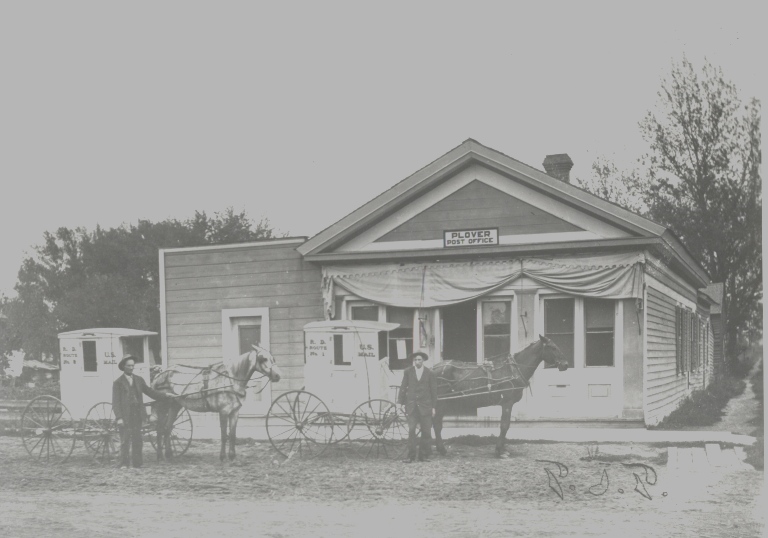These historical notes were gleamed from Malcolm Rosholt’s “Our County, Our Story”, from Michael Riley’s article “A History of Plover to 1984”, a list of historical notes found in the Town of Plover safe, historical newspapers and various family histories.
1836: The Wisconsin Territory was created and, at that time, a county to be called “Portage” was established. By 1841, Portage County had been enlarged to 57 miles wide and extended from the south – at the Wisconsin River near Fort Winnebago to Lake Superior and the Michigan border in the north; in 1849, the County Board split the county into three parts – the Middleton, Bull Falls and Plover townships. From then on, Portage County lost portions of its land as new counties were formed until when the last boundary change occurred in 1856 to create Wood County - Portage County has remained the same size since.
1844: During this year, the Village of Plover Portage came into prominence when an election made it the county seat – an election that was contended as not being fair since a lumber man brought in lumberjacks from the north to support the voters around Plover and Mill Creek. In 1845, the Village of Plover was first platted. Then in 1847 the federal government offered a mail route contract to Jacob L. Myers to run a stage line through the prairie and forestland in the area between Plover and Portage. According to author Malcolm Rosholt, Myers raised horses for his operation on a farm in Buena Vista.
1850: The building of the Buena Vista House, which became a popular stopping point on the stagecoach route in the 1850’s, permitted stagecoach travelers and others to take a breather before continuing their ride to Plover or on to Portage. Unique, even by today’s standards, this building featured a “rocking dance floor,” which may have been the only one of that type in the county, according to Rosholt. The special floor was built on levers that permitted it to sway up to 18 inches. “It was no doubt a popular place for teenagers of the period whirling about in the traditional cotillion, better known as the square dance,” Rosholt wrote. Jacob Myers son, Lon, a local auctioneer by day was frequently the square dance caller at the Buena Vista House.
As more and more people settled down in Plover, it didn’t take long before the Town began to gain a reputation as a heavy agricultural area. Large areas of land in Buena Vista and Almond were already in agricultural production by 1851. Cropland had begun to open up in the Town of Plover and surrounding areas.
1854: 130 voters elected their first Town Chairman, Thomas H. McDill, with 116 votes cast at the election held on April 4th. (The Poll List for 1854 is displayed in the Town Hall of the Town of Plover.)
1855: This era brought another notable structure to the Town of Plover - the Moore Barn, which was built near what was once known as Buena Vista Road. The barn survived into the 1920s, but when demolished, legend has it - several skeletons were found in the barn’s floor. These rumors may have circulated because, reportedly, bandits had routinely held up the stage as it passed through the pineries along the Buena Vista Road, according to Rosholt.
1857-58: A bill was introduced in the state legislature which changed the town’s name to the incorporated Village of Clayton but later in 1857, the Governor signed a bill and Plover became known as Algernon. Then, in 1858, residents requested another change and a new governor amended the name to the Village of Stanton.
1860: $25.00 was received from James Isherwood to license the Isherwood Hotel to serve liquor, according to Rosholt; another respite along the road in what is now the Town of Plover, the Isherwood Hotel was about two miles west of the infamous Moore Barn featuring a tavern house, dance hall and guest rooms. This structure remained until in the 1960-70’s when it was torn down.
1863: Indians invaded the area - between 5,000 and 6,000 - held a dance and passed a peace pipe; due to this excitement, a Civil War draft was postponed and, unfortunately in this same year, the Buena Vista House and its rocking dance floor were destroyed by tornado.
1864: Still not satisfied, the name was once again changed back to the Village of Plover; in that year, several cattle drives passed through Plover and Stevens Point on their way to Superior, and daily stage runs were occurring to Eau Pleine, Knowlton, Mosinee, Berlin, Almond and Wautoma.
1868: Thomas Mc Dill lost an election by over 100 votes to Raymond Burr who backed the highly contended move of the county seat to Stevens Point which lead to the demise of the Village of Plover; according to Malcolm Rosholt’s “Our County Our Story”. The village dissolved on or before 1870 with a population of 500 and the Town of Plover was later partitioned off to form what are now the Towns of Buena Vista, Grant, Stockton, and Linwood.
In 1874, Indians had killed 25 bears in the area. But as new roads were built, other establishments sprouted up in the Town of Plover - like Mathias Mitchell’s tavern house about a mile southeast of the Plover Town Square – known originally as Mitchell’s Tavern and later may have been renamed. In 1876 two railroads were beginning to serve the area.
.png)
